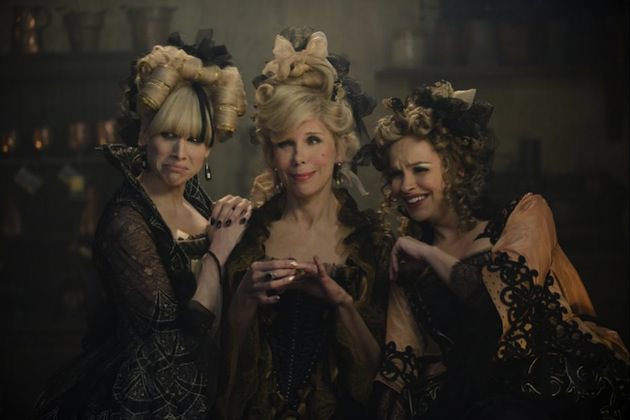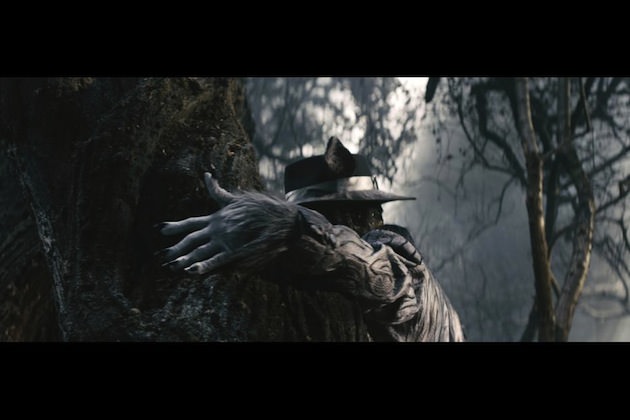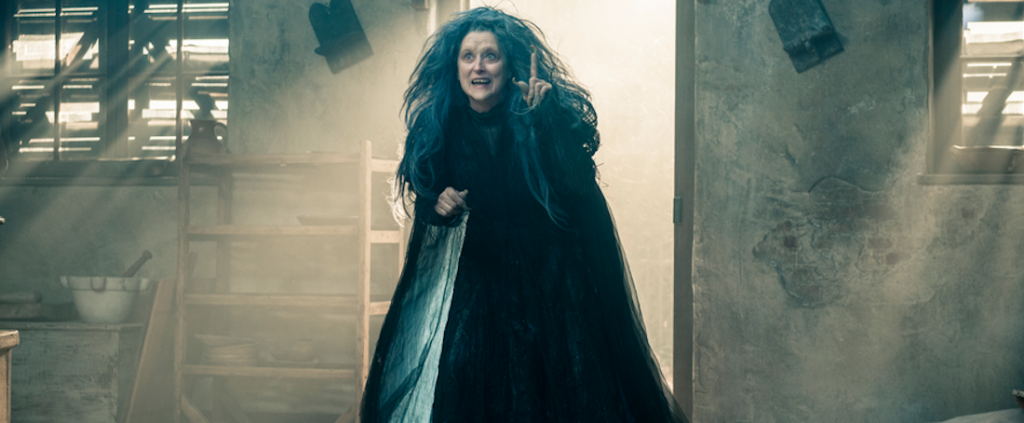Three-time Academy Award Winning Costume Designer Colleen Atwood Talks Shop
Colleen Atwood is one of the most prolific costume designers of her generation. She has never gone more than four years without a Oscar nomination, beginning with her work on Little Women in 1994 and leading up to her nomination for Snow White and the Huntsman in 2012. Atwood is responsible for one of the most iconic pieces of a costume in film history (more on this later), and has had her hand in some of Tim Burton’s greatest creations. She was feted at the Middleburg Film Festival, where she was given the Distinguished Costume Designer award (presented by fashion designer Kay Unger) and had a masquerade ball thrown in her honor.


We sat down to talk in the Salamander Resort and Spa’s lobby. Atwood was dressed in a pinstriped suit, looking regal, despite having flown in from London where she was finishing up her work on Alice in Wonderland: Through the Looking Glass. We began our discussion by talking about one of her personal favorite characters from any film she has worked, a shy young man with a bit of a cosmetic problem; he has scissors for hands.
Like many of Tim Burton’s most beloved characters, he had initially conceived of Edward Scissorhands years earlier, and while he was in pre-production on Beetlejuice, he had Caroline Thompson adapt his story into a screenplay. Yet it wasn’t until after the success of his Batman that the odd, heartfelt story of an artificial young man with blades for fingers would find a home at 20th Century Fox.
“I got flown in to meet Tim because his costume designer from Batman couldn’t do it,” Atwood says. “I got the job by default, really. He was interviewing other people, and it was the first time on a movie that I got hired at the end of the interview. It was a really good group of people, and it was the first time I met Johnny [Depp] and Winona [Ryder]. They were together at the time, and they were this cute little couple, they were babies.”
Atwood designed much of Edward’s leather-clad look by going out on scouting missions in New York. “What I did for Edward, what I often do, is I go out and look for materials, I have a vague idea of what I want, and at that time there were still all these leather shops on Orchard Street, so I went and found bits of leather and put them together. Going out on the street and digging around is still kind of a thought provoking part of the process for me.”
Atwood lamented the changes in New York, thanks in large part to the lunatic cost of real estate, that have made it impossible for a lot of those little shops to exist. No matter where the film is set, however, she goes out in search of materials that will grab her. “I don’t have a mission, I have my places, these magical spots all over the world that, there’s one fabric place in Paris I always go to, I just wander the streets and go to these certain places, like Portobello Road in London, which I go to early before it gets crazy. There’s always these places where you see these little quirky things that come into play. I have shoppers as well, who bring me things. I’m not a good internet shopper, I don’t have the patience for buying that way, I like to see things, touch things.”
Atwood recalled how little room for error she had with the costumes for Burton’s Edward. “The technology of filmmaking has changed so much since then. When I did Edward Scissorhands we had one costume that was the number one, then we had a number two that was just good, and then we had one stunt costume that was really janky. Now if you did a movie like that, you’d have a lot more of those hero, number one costumes.”
Atwood won her third Oscar for her work on Burton’s Alice in Wonderland in 2010, and just wrapped her work on Through the Looking Glass, which Burton’s producing and will premiere in 2016. She essentially had to be not only a designer, but the head of a small costume manufacturing business in order to outfit the hundreds of characters that populate the film. “I did so many more costumes than I ever thought I would. At the end of the day, we made almost two-thousand costumes. With all the day players, extras, crowds, it adds up.”
She usually has about four to five months to prep, where she can start designing and making the clothes. Once the movie is cast, she begins making the principals clothes, getting all her designs approved, the materials sourced and the costumes fitted. Then she begins designing for people who have smaller roles on the film. On a film like Through the Looking Glass, Atwood is also contributing to all the digital costumes, helping design them and tie them in to the fabrics and colors being worn by the actors. “The work starts four months out, and typically finishes the last week of filming. A movie like this just keeps growing and growing so you work throughout.”
Atwood is often thought of as Burton’s designer, but she’s worked on films for a number of equally talented directors, a few over them over and over again, like Rob Marshall and Jonathan Demme, and has made some of the most stunning costumes of the past thirty years. One creation in particular, Hannibal Lector’s mask and jumpsuit in The Silence of the Lambs, are two of the most iconic pieces of costume design ever made. When Atwood received the mask for Lecter, it was still untreated (they were planning on painting it white), but she loved the color as it was and left it unpainted. For his orange jumpsuit, it was a lot of trial and error before she got the color right.
“It was interesting because in fact for Lecter’s orange jumpsuit we had to try so many colors,” she says. “People weren’t manipulating film in post the way they are now. It had to be the right color there in the room, they couldn’t just fix it later. We did so many color tests for that orange, because on film a lot of times orange goes really red, so what looks orange on screen and what looks orange in the room aren’t the same thing.” For Jodie Foster’s Agent Starling, Atwood looked at the character’s psychology for inspiration. “She didn’t have a lot of money, but she wanted to look like she came from a different place in society, from the way she grew up. The key piece was really her duffle coat, because it made her vulnerable but also kind of classic and everyday. It resonated with people. Also it was a big deal at that time was to have Jodie with darker hair. People didn’t really want blondes to not be blonde, and that was also part of the whole design. I used a lot of murky greens on her costume, almost kind of military colors, they photographed well in the environments we were shooting in.”
She describes Demme’s The Silence of the Lambs set as a close-knit affair with a director she says is lovely and very loyal, and an entire team that was blissfully unaware they were making a film that would become a cultural touchstone. “We had dailies every night, and everybody brought their kids, and you’d sit, have a beer, and watch the dailies. It was really fun.”
For Memoirs of a Geisha, Atwood describes it as a gift from the Gods. She was going through some things on the home front that didn’t allow for her to work on Tim Burton’s Charlie and the Chocolate Factory, a film she was very much looking forward to diving into. Instead, she ended up landing the job with Rob Marshall on Geisha, and won another Academy Award for her efforts, her second win in three years. “From a design standpoint I was able to explore Japan and learn so much. I was humbled by the textile world that Japan has, and by the history of the geisha. It was not only an amazing design opportunity but also an educational opportunity.”
Atwood described how in Japan, their great artists are called ‘Living National Treasures,’ they can be anything from a weaver to a painter, and she had the chance to meet a couple of artists at that level. “One very graciously had us to his house, which was also his atelier. He was a famous kimono maker, and his family had been making kimonos for the royal family for 500-years, so he had this archive of how they used to present the designs to the emperors for their robes, and it was all these mounted library panels, and the history in that room was incredible.”
Atwood’s work on Chicago, which won her her first Oscar, came on the heels of her work on Burton’s Planet of the Apes. She sold Rob Marshall on hiring her to make the costumes for a film that would be a blur of precisely choreographed movement. Some people involved weren’t sure she was prepared to design for characters who would need to move in such a way, until she asked them to consider that she had just designed the wardrobe for a huge cast of hugely active anthropomorphic apes. She got the job. Marshall told her that he’d call her in six months after they’d worked out the choreography, and did just he said he would, flying her to New York for what she describes as one of the most incredible moments in her career.
Atwood arrived and watched, along with Marshall, four dancers perform the entire musical’s choreography. “It wish somebody would have recorded it. It was just a table, eight chairs, and four people in the room dancing, and it was the first time that I really understood the vision of choreography, because it was so spare you could really see it, there was nothing to distract you from what they were doing. It was incredible. It was just the music and the dance. Me, the production designer [John Myhre], the DP [Dion Beebe] and Marshall. It was really exciting.”


This year alone, Atwood designed for two films that couldn’t be more different, for two directors who go back to her again and again. One is Rob Marshall’s adaptation of Stephen Sondheim’s Into the Woods (Sondheim co-wrote the script with James Lapine, who wrote the book for his musical), which has Meryl Streep playing a witch who tries to teach invaluable lessons to the protagonists of several characters from famous children’s stories, including Little Red Riding Hood. The film has recently been the subject of a lupine-centric controversy, around the lack of a certain piece of anatomy for Johnny Depp’s wolf character that was definitely not missing from Sondheim’s original play. Atwood remains above the fray of this particular debate, however, and seemed merely amused by it when Janet Maslin, the former New York Times film critic, brought it to her attention at the Q&A. She also designed for her cinematic soul mate, Tim Burton, for his passion project Big Eyes (although most of his films are passion projects), about the painter Margaret Keane’s phenomenal success in the 1950s with her very bizarre creations, and the nefarious husband who tried stealing credit for her work.
Atwood might not be a household name, but she’s a monumental figure in the film world. She says what she likes the most about her job is she never works on the same kind of film twice. “Sometimes they’re a small little jewel, sometimes they’re a monster challenge…the fact that it’s different keeps you evolving.” And snagging Oscar nominations, apparently.
Featured image: Meryl Streep stars as the Witch in INTO THE WOODS, a modern twist on beloved fairy tales. Courtesy Walt Disney Studios.




